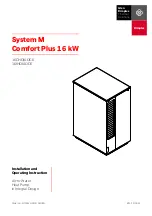
12. Troubleshooting
WARNING:
Turn off the power supply before performing any operations.
Do not allow the pump or motor to run when dry even for a short period
Strictly follow the user instructions and if necessary contact an authorised service centre
OFF
PROBLEM
1) The engine
does not start
2) Pump
blocked
3)The pump
functions but
no water
comes out
4) Insufficient
flow
5) Noise and
vibrations
from the pump
6) Leakage from
the mechani-
cal seal
PROBABLE CAUSES
1a) Unsuitable power supply
1b) Incorrect electrical connections
1c) Engine overload protective device
cuts in.
1d) Blown or defective fuses
1e) Shaft blocked
1f) Motor failed
2a) Prolonged periods of inactivity .
2b) Presence of solid bodies in the
impeller
2c) Bearings blocked
3a) Presence of air inside the pump or
suction pipe
3b) Possible infiltration of air.
3c) Foot valve blocked or suction
pipe not fully immersed in liquid
3d) Suction filter blocked
4a) Pipes and accessories with
diameter too small
4b) Presence of deposits or solid
bodies in the impeller
4c) Rotor deteriorated
4d) Worn rotor and pump case
4e) Gases dissolved in the water
4f) Excessive viscosity of the liquid
pumped
4g) Incorrect direction of rotation
5a) Worn bearings
5b) Unbalanced power supply
6a) The
mechanical
seal
has
functioned when dry or has stuck
6b) Mechanical seal scored by
presence of abrasive parts in the
liquid pumped
6c) Mechanical seal unsuitable for
the type of application
6d) Slight initial drip during filling or
on first start-up
POSSIBLE REMEDIES
1a) Check that the mains frequency and voltage are
suitable.
1b) Connect the power supply cable correctly. Check
the setting of the thermal overload protection.
1c) Check the power supply and make sure that the
pump shaft is turning freely. Check the setting of
the thermal overload protection.
1d) Replace the fuses, check points a) and c)
1e) See “Blocked pump” instruction booklet
1f) Repair or replace the engine.
2a) Unblock the pump by using a screw driver to turn
the relevant notch on the back of the shaft.
2b) Remove any solid foreign bodies inside the
impeller
2c) Replace the bearings.
3a) Release the air from the pump using the delivery
control valve.
3b) Check which part is not tight and seal the
connection.
3c) Clean or replace the bottom valve and use a
suitable suction pipe .
3d) Clean the filter, if necessary, replace it . See point
2b) also.
4a) Use pipes and accessories suitable for the
specific application
4b) Clean the impeller and install a suction filter
4c) Replace the impeller
4d) Replace the impeller and the pump casing
4e) Perform the opening and closing manoeuvres
through the feeder gate
4f) The pump is unsuitable
4g) Invert the electrical connections in the terminal
board
5a) Replace the bearings
5b) Check that the mains voltage is right
In cases 6a), 6b) and 6c), replace the seal
6a) Make sure that the pump casing is full of liquid and
that all the air has been expelled.
6b) Install a suction filter and use a seal suited to the
characteristics of the liquid being pumped.
6c) Choose a seal with characteristics suitable for the
specific application
6d) Wait for the seal to adjust to the rotation of the
shaft. If the problem persists, see points 6a), 6b)
or 6c).
GB
NM, NMS, NM4, NMS4 Rev. 25 - Operating Instructions
Page 15 / 88
IST NM 06_2017ed25_MXS 11_03con gall 30/05/17 08:30 Pagina 15
















































